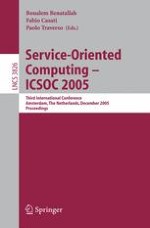2005 | OriginalPaper | Buchkapitel
SOA in the Real World – Experiences
verfasst von : Manoj Acharya, Abhijit Kulkarni, Rajesh Kuppili, Rohit Mani, Nitin More, Srinivas Narayanan, Parthiv Patel, Kenneth W. Schuelke, Subbu N. Subramanian
Erschienen in: Service-Oriented Computing - ICSOC 2005
Verlag: Springer Berlin Heidelberg
Aktivieren Sie unsere intelligente Suche, um passende Fachinhalte oder Patente zu finden.
Wählen Sie Textabschnitte aus um mit Künstlicher Intelligenz passenden Patente zu finden. powered by
Markieren Sie Textabschnitte, um KI-gestützt weitere passende Inhalte zu finden. powered by
We discuss our experiences in building a real-world, mission-critical enterprise business application on a service-oriented architecture for a leading consumer lending company. The application is composed of a set of services (such as
Credit Report Service, Document Management Service, External Vendor Service, Customer Management Service
, and
Lending Lifecycle Service
) that communicate among themselves mainly through asynchronous messages and some synchronous messages with XML payloads. We motivate the choice of SOA by discussing its tangible benefits in the context of our application. We discuss our experiences at every stage of the software development life cycle that can be uniquely attributed to the service oriented architecture, list several challenges, and provide an insight into how we addressed them in real-life. Some of the hard design and development challenges we faced were related to modeling workflow interactions between services, managing change analysis, and contract specification. In addition, SOA architecture and asynchronous messaging introduces fresh challenges in the area of integration testing (e.g. how do we test a system whose interface points are asynchronous messages) and in testing the robustness of the system (e.g. how do we deal with out of order messages, duplicate messages, message loss?). To address these challenges, we built a tool called
SOA Workbench
. We also discuss the techniques we adopted to address scenario-based validation that go beyond traditional document-centric validation based on XML Schema. Monitoring and error recovery, two key aspects of any mission-critical system, pose special challenges in a distributed SOA-based, asynchronous messaging setting. To address these, we built a tool called
SIMON
. We discuss how SIMON helps error detection and recovery in a production environment. We conclude by listing several opportunities for further work for people in both academia and industry.
